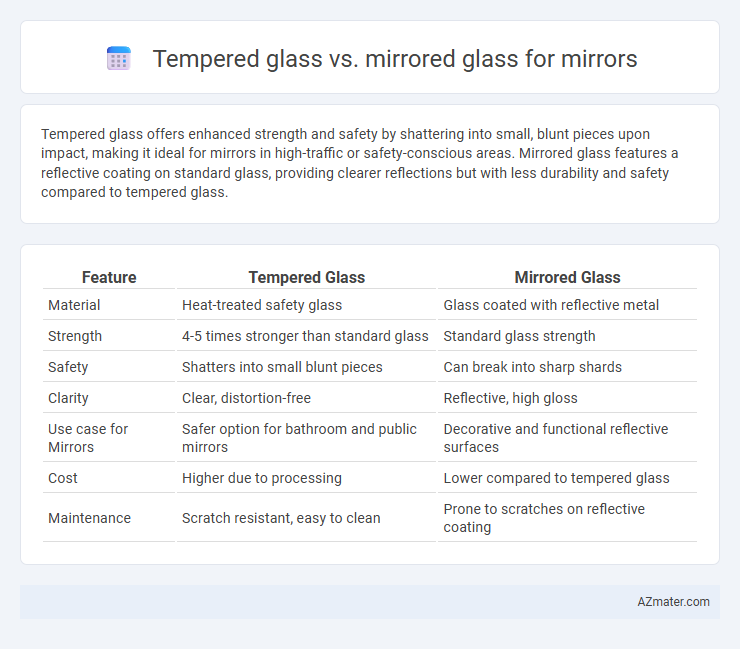Tempered glass offers enhanced strength and safety by shattering into small, blunt pieces upon impact, making it ideal for mirrors in high-traffic or safety-conscious areas. Mirrored glass features a reflective coating on standard glass, providing clearer reflections but with less durability and safety compared to tempered glass.
Table of Comparison
| Feature | Tempered Glass | Mirrored Glass |
|---|---|---|
| Material | Heat-treated safety glass | Glass coated with reflective metal |
| Strength | 4-5 times stronger than standard glass | Standard glass strength |
| Safety | Shatters into small blunt pieces | Can break into sharp shards |
| Clarity | Clear, distortion-free | Reflective, high gloss |
| Use case for Mirrors | Safer option for bathroom and public mirrors | Decorative and functional reflective surfaces |
| Cost | Higher due to processing | Lower compared to tempered glass |
| Maintenance | Scratch resistant, easy to clean | Prone to scratches on reflective coating |
Introduction to Tempered Glass and Mirrored Glass
Tempered glass is a type of safety glass processed by controlled thermal or chemical treatments to increase its strength compared to normal glass, making it highly resistant to impact and thermal stress. Mirrored glass consists of a glass substrate coated with a reflective material, often silver or aluminum, designed to create a reflective surface for mirrors and decorative applications. Both materials offer distinct advantages, with tempered glass providing durability and safety, while mirrored glass emphasizes clarity and reflectivity for optimal mirror performance.
Understanding Tempered Glass: Key Properties
Tempered glass is a safety glass processed through controlled thermal or chemical treatments to increase its strength compared to normal glass, making it resistant to impact and thermal stress. In mirror applications, tempered glass offers durability and shatter resistance, ensuring safer use in environments prone to sudden temperature changes or physical impact. Its key properties include enhanced mechanical strength, fragmentation into small blunt pieces when broken, and superior thermal stability, making it a practical choice for high-quality mirrors.
What is Mirrored Glass? Features and Applications
Mirrored glass is a type of glass coated with a reflective metal layer, typically silver or aluminum, creating a shiny, reflective surface used in decorative and functional applications. Key features include high reflectivity, durability, and the ability to customize tint and finish, making it ideal for interior design, architectural facades, and automotive mirrors. Common applications span home mirrors, bathroom vanities, furniture accents, and security mirrors, where both aesthetics and functionality are essential.
Durability: Comparing Strength and Safety
Tempered glass offers superior durability compared to mirrored glass due to its enhanced strength and resistance to impact, making it less prone to shattering. When broken, tempered glass crumbles into small, blunt pieces, significantly reducing injury risk, whereas traditional mirrored glass tends to break into sharp, dangerous shards. This safety feature, combined with its toughness, makes tempered glass a preferable choice for mirrors in high-traffic or safety-conscious environments.
Aesthetic Differences: Clarity and Reflection Quality
Tempered glass offers superior clarity and a crisp, true reflection, making it ideal for high-quality mirrors where detail accuracy is essential. Mirrored glass, coated with a reflective metallic layer, may produce slightly muted or distorted reflections due to surface imperfections or oxidation over time. The aesthetic difference lies in tempered glass's durability and sharp visual fidelity versus mirrored glass's often more decorative but less precise reflective qualities.
Application Suitability: Interior vs Exterior Use
Tempered glass offers superior strength and safety, making it ideal for exterior mirror applications exposed to harsh weather or potential impacts, while mirrored glass excels in interior settings where aesthetic appeal and delicate reflective qualities are prioritized. Its shatter-resistant properties ensure tempered glass withstands outdoor environments with durability and security, whereas mirrored glass typically suits indoor environments such as bathrooms, dressing rooms, and decorative wall mirrors. Choosing between tempered and mirrored glass depends on balancing impact resistance and reflective clarity relative to the mirror's location and environmental demands.
Maintenance and Cleaning: Which is Easier?
Tempered glass mirrors offer superior durability and resistance to scratches, making maintenance and cleaning simpler with just a soft cloth and mild detergent. Mirrored glass, while aesthetically appealing, often requires more careful cleaning to avoid damaging the reflective backing and may show fingerprints and smudges more prominently. Tempered glass is generally easier to maintain long-term due to its strength and resilience against common cleaning agents.
Cost Comparison: Budget Considerations
Tempered glass for mirrors generally costs more upfront due to its safety features and durability, making it ideal for high-traffic or commercial spaces where breakage risk is higher. Mirrored glass, often more budget-friendly, provides aesthetic appeal at a lower price point but lacks the enhanced strength and safety of tempered options. Cost considerations should weigh initial investment against long-term value, especially in environments demanding safety and resilience.
Environmental Impact and Sustainability
Tempered glass and mirrored glass differ significantly in environmental impact and sustainability, as tempered glass is more recyclable due to its lack of coatings or chemical treatments, reducing waste in manufacturing cycles. Mirrored glass often contains metallic coatings like silver or aluminum, complicating recycling processes and increasing energy consumption during production. Choosing tempered glass for mirrors supports eco-friendly practices by minimizing chemical usage and promoting material reuse.
Choosing the Best Glass for Your Mirror
Choosing the best glass for your mirror involves balancing durability and clarity, with tempered glass offering high strength and safety due to its shatter-resistant properties. Mirrored glass provides superior reflection quality and aesthetic appeal by combining a polished glass surface with a reflective coating, but typically lacks the enhanced safety features of tempered glass. For environments requiring both safety and optimal reflection, selecting tempered mirrored glass ensures maximum impact resistance without compromising visual performance.

Infographic: Tempered glass vs Mirrored glass for Mirror
 azmater.com
azmater.com